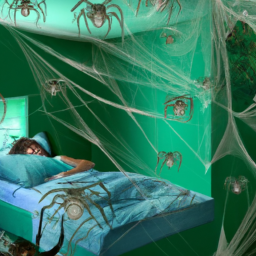According to the saying, “a good night’s sleep sets the stage for a productive day.”
However, for those who suffer from anxiety dreams, a restful night’s sleep can seem like an impossible feat. Anxiety dreams are vivid and unsettling experiences that leave us feeling anxious and drained upon waking up. They often reflect our deepest fears and worries, making it difficult to shake off their impact on our daily lives.
But fear not! There are steps we can take to stop anxiety dreams and improve the quality of our sleep. In this article, I will share with you some practical tips and techniques that have helped me overcome my own struggles with anxiety dreams.
From keeping a dream journal to creating a relaxing sleep environment, these strategies have proved effective in reducing the frequency and intensity of my anxiety dreams. So let’s dive in and start getting the peaceful rest we deserve!
Key Takeaways
- Keeping a dream journal can help identify patterns or triggers causing anxiety dreams
- Practicing relaxation techniques such as deep breathing, progressive muscle relaxation, and visualization can help manage anxiety dreams
- Creating a consistent bedtime routine that promotes relaxation and calmness is important for getting a good night’s sleep
- Seeking professional help from a therapist or healthcare provider may be necessary if anxiety dreams persist
Understanding Anxiety Dreams
So, you’re probably wondering why those anxiety dreams keep haunting you every night. Well, let me tell you, they’re not just random nightmares.
Anxiety dreams are a reflection of your subconscious mind’s response to stress and anxiety in your waking life. Understanding dream symbolism is essential in decoding these dreams as they often contain hidden messages about our thoughts and emotions.
Moreover, the impact of anxiety dreams on sleep quality cannot be ignored. These dreams can cause restless sleep, leading to fatigue and a reduced ability to concentrate during the day.
Therefore, it’s crucial to recognize the significance of these dreams and find ways to prevent them from recurring. Keeping a dream journal is an excellent way of doing so as it allows us to identify patterns or triggers that may be causing these unpleasant experiences.
Keep a Dream Journal
Keeping a dream journal has been instrumental in helping me understand and work through my anxiety dreams. Not only does it allow me to remember my dreams more vividly, but it also helps me identify any recurring themes or patterns.
In this discussion, I’ll explore the benefits of keeping a dream journal, offer tips on how to start one, and share techniques for analyzing your dreams.
Benefits of Keeping a Dream Journal
As you explore the depths of your mind through journaling your dreams, you may uncover hidden symbols that hold the key to unlocking your anxiety and finding peace. Keeping a dream journal comes with its own set of benefits that can aid in tracking progress and interpreting dreams.
Here are four ways keeping a dream journal can help you stop anxiety dreams:
-
Provides insight into subconscious thoughts: When we sleep, our subconscious takes over, leading to vivid dreams that reflect our innermost thoughts and feelings. By recording these dreams in a journal, we gain insight into our subconscious mind.
-
Helps identify patterns: When we keep track of our dreams over time, we start to notice patterns emerging. These patterns can offer clues about what triggers anxiety dreams and how to avoid them.
-
Promotes self-reflection: Dream journaling encourages self-reflection as it prompts us to think deeply about our emotions and experiences.
-
Allows for catharsis: Writing down anxious or distressing dreams can be cathartic in itself as it helps release pent-up emotions.
By keeping a dream journal, we gain valuable insights into ourselves that can help us understand and overcome our anxiety dreams.
In the next section, we’ll delve deeper into how to keep a dream journal effectively without missing any important details.
How to Keep a Dream Journal
To effectively keep a dream journal, you can start by picking out a notebook that feels special to you and keeping it by your bedside each night. This will help you remember to record your dreams as soon as you wake up. You can also set an intention before going to bed that you want to remember your dreams and gain insight from them.
When recording your dreams in the journal, try to write down as much detail as possible. Include any emotions or sensations you felt during the dream, and any significant symbols or people that appeared. Dream interpretation is not an exact science, but keeping a record of your dreams over time may reveal patterns or recurring themes that could provide valuable insight into your subconscious mind. Additionally, practicing lucid dreaming techniques can allow for more control over the content of your dreams and enhance self-awareness. Analyzing your dreams can lead to greater understanding of yourself and ultimately help reduce anxiety in waking life.
Analyzing Your Dreams
If you want to uncover the hidden messages in your dreams, dive deep into the symbolism and imagery that your subconscious mind conjures up while you’re asleep.
Every dream contains symbols that represent different aspects of our lives, and interpreting these symbols can help us understand our deepest fears and desires.
One way to interpret symbols is through lucid dreaming, a technique where you become aware that you’re in a dream and can control its content. This allows you to explore the dream world with more consciousness, making it easier to identify recurring themes or symbols.
By keeping a dream journal and practicing lucid dreaming, you may be able to gain insight into your subconscious mind and develop a deeper understanding of yourself.
To practice relaxation techniques…
Practice Relaxation Techniques
When I struggle with anxiety dreams, one of the techniques that helps me the most is practicing relaxation techniques.
Deep breathing exercises are a simple and effective way to calm my body and mind.
Progressive muscle relaxation involves tensing and releasing different muscle groups to release tension from head to toe.
Lastly, visualization techniques help me imagine a relaxing scene or scenario to ease my anxiety and promote deep relaxation.
Give these techniques a try next time you’re feeling stressed or anxious before bed!
Deep Breathing Exercises
Take a moment to simply breathe deeply, letting your body relax and release tension. Breathing exercises are an effective way to calm your mind and reduce anxiety levels.
Here are some mindfulness techniques that can help you practice deep breathing:
- Inhale deeply through your nose, counting to four.
- Hold your breath for a few seconds.
- Exhale slowly through pursed lips, counting to six.
- Repeat the process several times until you feel more relaxed.
- Visualize yourself in a calm and peaceful place while doing these exercises.
These deep breathing exercises can be done anywhere and at any time when you feel overwhelmed by anxiety dreams. They will help you slow down your racing thoughts and bring focus back to the present moment.
As you become more comfortable with this practice, consider incorporating other mindfulness techniques into your routine, such as progressive muscle relaxation.
By practicing these relaxation techniques consistently, you’ll be better equipped to manage anxiety dreams when they occur.
The next step is learning how to use progressive muscle relaxation as another tool in managing stress levels.
Progressive Muscle Relaxation
You can easily relieve tension and stress in your body with progressive muscle relaxation. This technique involves tensing and relaxing each muscle group in your body, starting from the toes and working your way up to the head. By doing so, you become more aware of the sensations in your body and learn to recognize when it’s tense versus relaxed.
Muscle relaxation techniques have a host of benefits for those who suffer from anxiety dreams. It not only helps reduce physical tension but also calms the mind, making it easier to fall asleep and stay asleep throughout the night. Additionally, regular practice of these techniques can lead to improved overall health by reducing blood pressure, heart rate, and muscle soreness.
Now that we’ve learned about progressive muscle relaxation, let’s move on to visualization techniques for stopping anxiety dreams.
Visualization Techniques
Transition: While Progressive Muscle Relaxation is a great technique to reduce muscle tension and promote relaxation, there are other methods that can be just as effective in stopping anxiety dreams. One of these techniques includes visualization, which can help calm the mind and bring about positive feelings.
Current Subtopic: When it comes to stopping anxiety dreams, guided meditation and positive affirmations through visualization can be a powerful tool. Guided meditation involves listening to an instructor who will guide you through the process of focusing on your breath or imagining a peaceful scene. This helps redirect your thoughts away from stressful situations or worries that may cause anxiety dreams. On the other hand, positive affirmations involve repeating words or phrases that inspire self-confidence and positivity in yourself. This technique can help change negative thinking patterns into more positive ones.
To better understand how guided meditation and positive affirmations can work together to stop anxiety dreams, let’s take a look at this table:
| Guided Meditation | Positive Affirmations |
|---|---|
| Helps redirect thoughts away from stressors | Can change negative thinking patterns |
| Promotes relaxation | Builds self-confidence |
| Encourages mindfulness | Focuses on positivity |
Incorporating these techniques into your bedtime routine can greatly reduce anxiety dreams and promote quality sleep. By calming the mind before bed with visualization techniques such as guided meditation and positive affirmations, you may find yourself drifting off into a peaceful slumber without any disruptive dreams.
Transition: Now that we have explored some effective ways to stop anxiety dreams through progressive muscle relaxation and visualization techniques, let’s move onto creating a bedtime routine to further promote restful sleep without any interruptions.
Create a Bedtime Routine
I’ve learned from experience that having a bedtime routine can do wonders for getting a good night’s sleep. That’s why I want to share with you the importance of establishing a consistent bedtime routine, as well as some tips on how to create one.
Additionally, I’ll provide some relaxing activities to include in your routine that will help you wind down and prepare for restful sleep.
The Importance of a Bedtime Routine
As I’m winding down for the night, I understand the importance of consistency in establishing a bedtime routine. Incorporating self-care practices, such as meditation, reading, or taking a warm bath, can help soothe the mind and body before sleep. By doing so, you’re essentially unlocking peaceful sleep and reducing anxiety dreams.
Creating a bedtime routine isn’t just about going to bed at the same time every night. It’s about incorporating activities that promote relaxation and calmness, allowing yourself to transition from wakefulness to restfulness.
In the next section, I’ll share some tips on how you can create a bedtime routine that works for you without feeling like it’s one more thing to add to your already busy schedule.
Tips for Creating a Bedtime Routine
To create a comforting bedtime routine that suits your needs, you can start by picking a relaxing activity like taking a warm bath or reading a book. Additionally, incorporating breathing exercises and meditation into your routine can help calm your mind and reduce anxiety before bed.
Here are some tips for creating a calming bedtime routine:
| Activity | Benefits |
|---|---|
| Taking a warm bath or shower | Relaxes muscles and reduces tension |
| Reading a book | Reduces stress by distracting the mind |
| Writing in a journal | Helps release negative thoughts and emotions |
| Practicing breathing exercises or meditation | Calms the mind and reduces anxiety |
Incorporating these activities into your bedtime routine can help promote relaxation and improve sleep quality. In the next section, we’ll explore some other relaxing activities to include in your routine.
Relaxing Activities to Include
Including relaxing activities in your bedtime routine can promote better sleep. It’s important to wind down and let go of the stresses of the day before trying to fall asleep.
Outdoor activities, such as taking a walk or doing some gentle yoga poses, can help you connect with nature and release any tension in your body. Creative hobbies like drawing, knitting, or coloring can also be great ways to unwind and focus on something calming.
In addition to these activities, it’s helpful to avoid triggers before bed that might contribute to anxiety dreams. This could include watching scary movies or reading intense news articles.
By incorporating relaxing activities into your bedtime routine and being mindful of what you expose yourself to before going to sleep, you’ll be setting yourself up for a more peaceful night’s rest.
Avoid Triggers Before Bed
Before hitting the hay, make sure you steer clear of any potential triggers that may set off your anxiety dreams. This means avoiding stimulating activities such as watching intense movies or shows, playing video games, or scrolling through social media before bed.
Instead, opt for calming nighttime habits such as reading a book, taking a warm bath, or practicing meditation. It’s also important to prioritize stress management throughout the day to prevent anxiety from building up and carrying over into your dreams.
Try incorporating exercise into your daily routine to release endorphins and reduce tension in the body. Remember that consistent self-care practices can greatly improve not only the quality of your sleep but also your overall well-being.
Exercise Regularly
Regular exercise can do wonders for your mental and physical health, helping you to feel more energized and focused throughout the day. Not only does it improve your overall well-being, but it can also help curb those anxiety dreams that keep you up at night.
Yoga, in particular, has become a popular form of exercise for reducing stress and promoting relaxation. Its combination of physical movement and mindfulness techniques can help calm the mind and ease tension in the body.
The best time to exercise varies from person to person, but generally speaking, it’s best to avoid exercising too close to bedtime as it may make it harder to fall asleep. Instead, aim to exercise earlier in the day or at least a few hours before bedtime.
By incorporating regular exercise into your routine, you’ll be taking an active step towards reducing anxiety dreams and promoting better sleep habits. Speaking of sleep…
Get Enough Sleep
Getting enough sleep is crucial for maintaining good physical and mental health, as it allows the body to repair and recharge. Improving sleep hygiene can be a simple yet effective way to stop anxiety dreams. Sleep hygiene refers to the habits and practices that promote healthy sleeping patterns.
To improve your sleep hygiene, start by creating a relaxing bedtime routine. Avoid using electronic devices before bed, as the blue light emitted by screens can interfere with your body’s natural production of melatonin, a hormone that promotes sleep. Additionally, ensure that your sleeping environment is comfortable and conducive to restful sleep by keeping your bedroom cool, quiet, and dark.
By implementing these changes into your daily routine, you may find that you are able to get a better night’s rest and reduce the frequency of anxiety dreams.
Transitioning into seeking professional help for anxiety: While improving your sleep hygiene can be helpful in reducing anxiety dreams, sometimes additional support may be necessary. If despite making these changes you are still struggling with anxiety or experiencing frequent nightmares, seeking professional help from a therapist or healthcare provider may be beneficial in addressing underlying issues contributing to this problem.
Seek Professional Help
If you’re still struggling with persistent anxiety dreams, seeking professional help may be the best option for you. A therapist or healthcare provider can assist in identifying any underlying issues that may be contributing to your disturbed sleep patterns. They can offer counseling benefits such as coping strategies, relaxation techniques, and cognitive-behavioral therapy.
Finding resources for mental health care is easier than ever before. Many healthcare providers offer telehealth appointments, allowing you to receive treatment from the comfort of your own home. Don’t hesitate to reach out for help if you feel like your anxiety dreams are affecting your daily life.
In the next section, we’ll discuss ways to create a relaxing sleep environment that can further aid in reducing nighttime disturbances.
Create a Relaxing Sleep Environment
When I struggle with anxiety dreams, creating a relaxing sleep environment has been key for me. I recommend testing out different options before making a purchase to choose the right mattress that is crucial for comfort and support.
Maintaining an ideal room temperature and reducing noise and light can also help promote restful sleep.
Choosing the Right Mattress
To make sure you get a good night’s rest and avoid anxiety dreams, it’s important to choose the right mattress that fits your body type and sleeping preferences.
Mattress firmness is crucial in determining how well you sleep at night. If your mattress is too soft or too hard, it can cause discomfort and lead to restless nights. A medium-firm mattress is usually recommended as it provides enough support for your back while also being comfortable enough to sleep on.
Another thing to consider when choosing a mattress is its size. Make sure to pick one that fits your room and sleeping habits. If you’re sharing a bed with someone, a queen or king-sized bed might be more suitable as it allows for more space and less disturbance during the night.
Remember, investing in a good quality mattress that suits your needs can go a long way in improving your sleep quality and reducing anxiety dreams.
When it comes to getting better sleep, having an ideal room temperature is equally important as having the right mattress.
Ideal Room Temperature
Choosing the right mattress can definitely help with getting a good night’s sleep, but there are other factors that come into play as well. One of them is room temperature. Personally, I find it difficult to fall asleep when it’s too hot or too cold in my bedroom. That’s why adjusting the thermostat to an ideal room temperature is crucial for a restful sleep.
But what’s the ideal room temperature, you may ask? Well, this varies from person to person, but generally speaking, experts recommend keeping your bedroom between 60 and 67 degrees Fahrenheit (15 and 19 degrees Celsius). This may sound chilly at first, but trust me – it works wonders for regulating your body temperature and preventing night sweats.
Additionally, using essential oils like lavender or chamomile can create a calming atmosphere and promote relaxation before bedtime. Set your thermostat to an optimal temperature range, experiment with different essential oils known for promoting sleep, and create a relaxing ambiance in your bedroom.
Now that we’ve covered how to optimize our sleeping environment by adjusting the thermostat and incorporating essential oils, let’s move on to another important factor: reducing noise and light.
How to Reduce Noise and Light
Reducing noise and light is essential for a peaceful night’s sleep, so let’s explore some ways to create a tranquil atmosphere in your bedroom. Soundproof curtains and dimmer switches are great options to reduce the amount of noise and light entering your room. Soundproof curtains can block out external noises such as traffic or neighbors’ conversations, making it easier for you to fall asleep and stay asleep throughout the night. Dimmer switches can help create a relaxing environment by allowing you to adjust the brightness of your lights according to your preference.
Another option is to use white noise machines and blackout curtains. White noise machines produce a consistent sound that helps mask other noises that may disrupt your sleep, while blackout curtains block out all outside light sources, ensuring complete darkness in your bedroom. By reducing both noise and light, you can create an ideal sleeping environment that promotes better rest and relaxation. Remember, getting quality sleep takes time and effort, but with patience and consistency, you’ll start seeing positive results in no time.
Transitioning into the subsequent section about ‘stay positive and patient’, it’s important to remember that creating an ideal sleeping environment takes time and experimentation with different methods. Don’t get discouraged if one method doesn’t work for you right away; keep trying until you find what works best for you.
Stay Positive and Patient
Staying positive and patient is key when trying to stop anxiety dreams, because it takes time and effort to change our thought patterns. A positive mindset helps us focus on the good things in life, while patience allows us to take small steps towards achieving our goals.
One way to cultivate a positive mindset is by practicing gratitude regularly. This means taking the time to appreciate what we have in our lives, rather than focusing on what we lack.
Another effective technique for staying positive and patient is mindfulness meditation. This involves being present in the moment and observing our thoughts without judgment. By doing so, we can become more aware of our negative thought patterns and learn how to redirect them towards more positive ones.
It’s important to remember that changing our thought patterns is a process that takes time and practice, but with patience and perseverance, we can overcome anxiety dreams and live a more peaceful life.
Frequently Asked Questions
How do anxiety dreams differ from regular dreams?
Anxiety dreams are characterized by their vividness and emotional intensity. Unlike regular dreams, they can leave a lasting impact on our psyche, causing feelings of fear, stress, and unease. Exploring the psychological impact of anxiety dreams is crucial to understanding their significance in our lives.
Can anxiety dreams be a sign of a deeper underlying issue?
Possible output:
Anxiety dreams may indicate deeper issues like repressed emotions. It’s worth exploring their causes and seeking support if they recur. Therapy can help address underlying stressors and promote better sleep.
Is it possible to completely stop having anxiety dreams?
Stopping anxiety dreams completely may not be possible, but there are ways to cope. Seeking professional help and practicing relaxation techniques can lessen the frequency and intensity of these dreams. Like waves on a shore, they can ebb and flow.
Can medication be used to treat anxiety dreams?
Medication can be effective in treating anxiety dreams, but it’s important to explore alternatives such as therapy and lifestyle changes. It’s best to consult a healthcare professional to determine the best course of action for managing anxiety dreams.
Are there any natural remedies that can help reduce anxiety dreams?
Relaxation techniques like yoga or meditation can reduce stress and anxiety before bed, helping to prevent anxiety dreams. Taking herbal supplements such as valerian root or chamomile tea may also promote relaxation and improve sleep quality.
Conclusion
In conclusion, anxiety dreams can be distressing and disruptive to our overall well-being. However, there are steps we can take to stop them from occurring or minimize their frequency.
By keeping a dream journal, practicing relaxation techniques such as deep breathing and meditation, creating a bedtime routine, avoiding triggers before bed, and getting enough sleep, we can create a better sleep environment for ourselves.
It’s important to remember that seeking professional help may also be necessary in managing anxiety dreams. A licensed therapist or counselor can provide additional guidance and support in addressing the underlying causes of these dreams.
So let’s stay positive and patient in our journey towards restful sleep. With consistent effort and self-care practices, we can overcome anxiety dreams and achieve peaceful nights of slumber.










